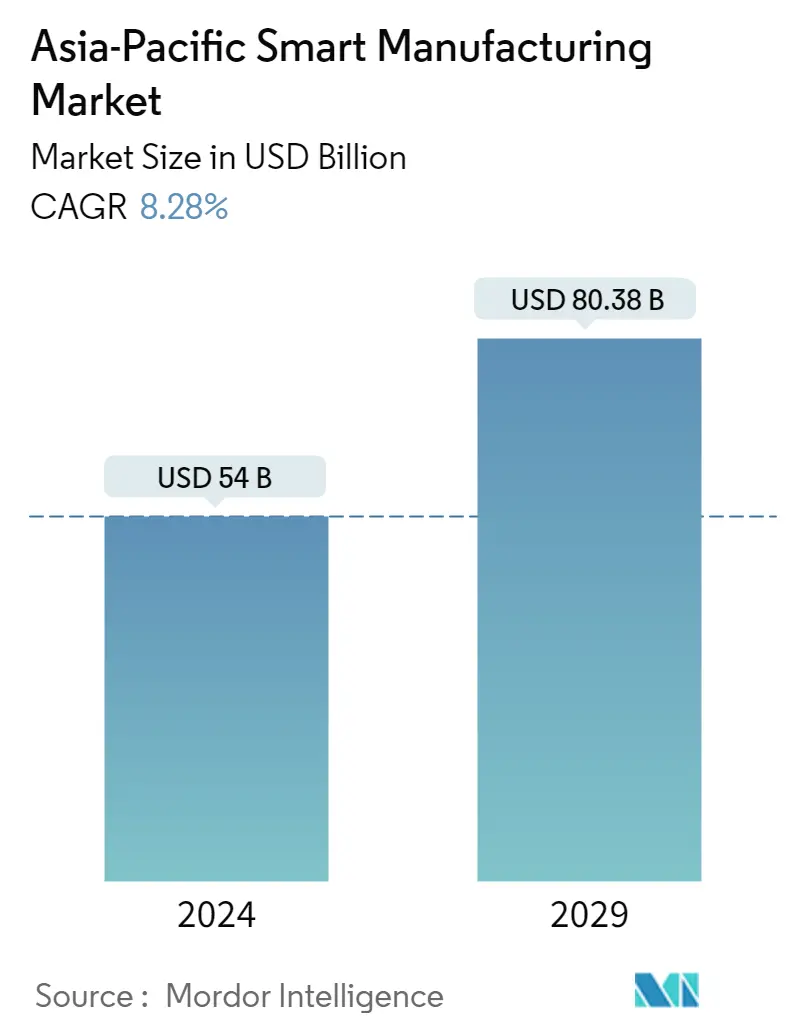Market Size of Asia-Pacific Smart Manufacturing Industry

| Study Period | 2019 - 2029 |
| Base Year For Estimation | 2023 |
| Market Size (2024) | USD 54.00 Billion |
| Market Size (2029) | USD 80.38 Billion |
| CAGR (2024 - 2029) | 8.28 % |
| Market Concentration | Low |
Major Players
*Disclaimer: Major Players sorted in no particular order |
Need a report that reflects how COVID-19 has impacted this market and its growth?
APAC Smart Manufacturing Market Analysis
The Asia-Pacific Smart Manufacturing Market size is estimated at USD 54 billion in 2024, and is expected to reach USD 80.38 billion by 2029, growing at a CAGR of 8.28% during the forecast period (2024-2029).
Manufacturing is one of the most significant contributors to Asia-Pacific's economy and is undergoing a rapid transformation. As the population ages, along with rising labor costs in Europe and North America, the legacy model based on inexpensive workers is no longer sustainable. Due to such factors, low-end manufacturing firms are increasingly moving their operations to Southeast Asia to cut costs.
- Industry 4.0 is the latest revolution in the manufacturing landscape. Factories integrate production machines, wireless connectivity, and sensors and link them to a system platform ecosystem that oversees the production line process and executes decisions autonomously. With the help of smart manufacturing, regional manufacturers can transform businesses and achieve significant value by leveraging the Industrial Internet of Things (IIoT), cloud, and analytics solutions.
- Big data analytics can refine complicated processes and support new business models, like mass customization and product-as-a-service (which can be made possible by smart manufacturing), apart from the traditional operational models like "on-demand." As big data analytics allows an enterprise to use smart manufacturing to shift from reactionary practices to predictive ones, The increase in industrial 4.0 practices across various manufacturing industries provides more scope for accepting big data analytics in the region.
- Manufacturing has emerged as one of the high-growth sectors in India. The "Make in India" program places India on the world map as a manufacturing hub and provides global recognition to the Indian economy. In order to succeed in the "Make in India" program, manufacturers in India need to manufacture more efficiently and deploy innovation to stay competitive. Smart manufacturing solutions can help with that. Manufacturers can focus more on enhancing competitiveness by streamlining supply chains, reducing costs, and improving safety in the workplace. Simultaneously, solutions like robotics, analytics, and cybersecurity strengthen their ability to meet quality norms.
- Further, the automated industrial economy has opened in Japan, and the development of Industrial Version 4.0 is speeding up. Japan has become a manufacturing hub for factory automation products, supplying them to other regional markets in the Asia-Pacific region and making factory automation more affordable. Products from Japan are prone to lower shipment costs and have better after-sales support networks in the region.
- With the Made in China 2025 initiative allowing the relocation of manufacturing back to China, Southeast Asian countries are under pressure to ascertain and minimize the risk of labor issues, and Industry 4.0 is currently impacting smart manufacturing development in the region. Moreover, most regional companies need to become more familiar with the benefits of Industry 4.0 on productivity and growth. It is estimated that if adopted and implemented correctly, Industry 4.0 has the potential to increase productivity by 30-40%.
